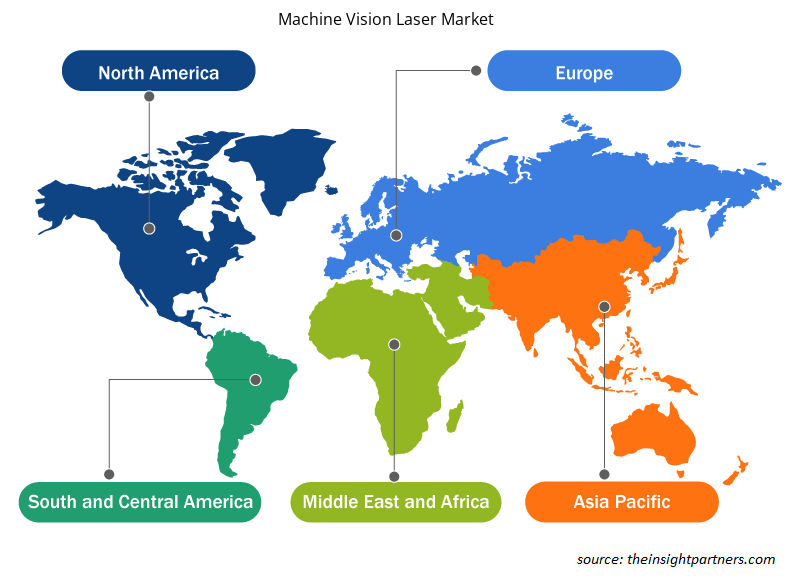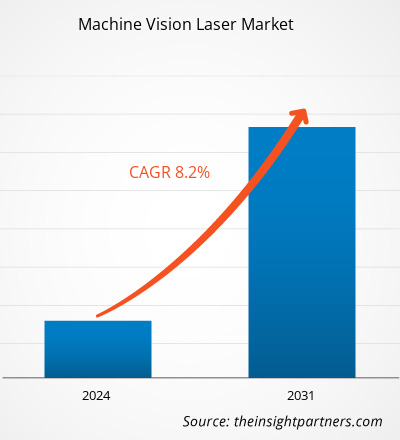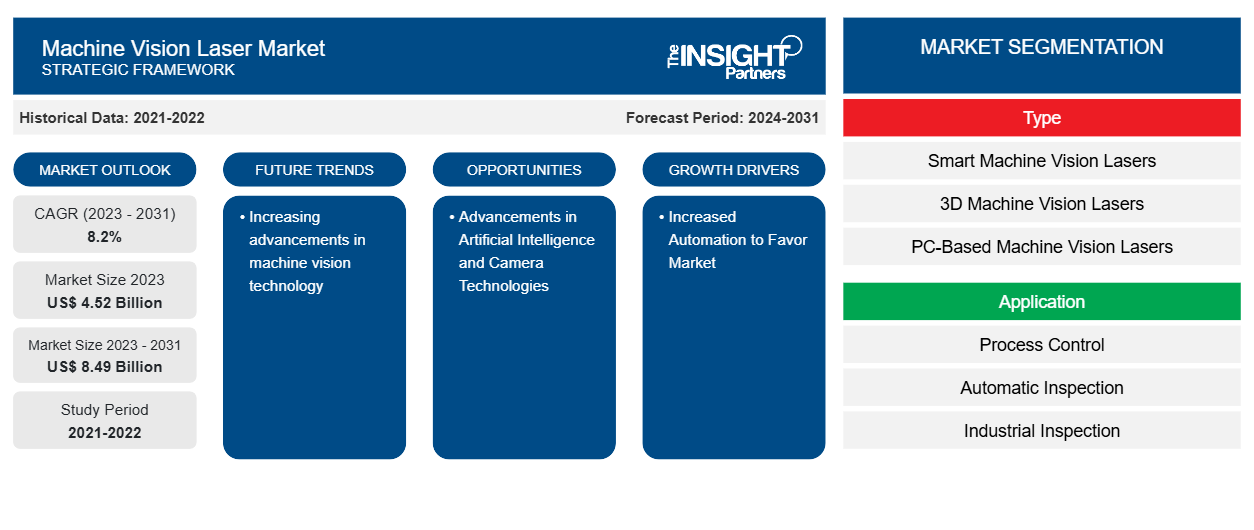Si prevede che le dimensioni del mercato globale dei laser per la visione artificiale cresceranno da 4,52 miliardi di dollari nel 2023 a 8,49 miliardi di dollari entro il 2031; si prevede che si espanderà a un CAGR dell'8,2% dal 2024 al 2031. I crescenti progressi nella tecnologia della visione artificiale rimarranno probabilmente una tendenza chiave del mercato dei laser per la visione artificiale.CAGR of 8.2% from 2024 to 2031. The increasing advancements in machine vision technology are likely to remain a key machine vision laser market trends.
Analisi del mercato dei laser per la visione artificiale
Si prevede che la crescente necessità di controlli di qualità e di automazione avanzati in vari settori verticali alimenterà la crescita del mercato.
Panoramica del mercato dei laser per la visione artificiale
I sistemi laser di visione artificiale (MV) utilizzano videocamere, elaborazione del segnale digitale e conversione analogico-digitale per consentire ai computer di visualizzare, esaminare e valutare le prestazioni del lavoro. Questi sistemi raccolgono dati, che vengono successivamente inviati a un computer per l'elaborazione e la produzione dell'output richiesto. Risoluzione e sensibilità sono due parametri critici nei sistemi MV. La risoluzione determina la capacità del sistema di distinguere tra le cose. Allo stesso tempo, la sensibilità si riferisce alla capacità della macchina di identificare oggetti o segnali deboli in condizioni di scarsa illuminazione o a lunghezze d'onda invisibili all'occhio umano. Questi sistemi sono fondamentali nella gestione degli ambienti di lavoro, comprese funzioni come il controllo dei processi, la guida robotica e l'ispezione automatizzata nelle applicazioni industriali.MV) laser systems use video cameras, digital signal processing, and analog-to-digital conversion to let computers to view, examine, and assess job performance. These systems collect data, which is subsequently sent to a MV systems. Resolution determines the system's capacity to distinguish between things. At the same time, sensitivity refers to the machine's capacity to identify objects or weak signals in low-light settings or at wavelengths that are invisible to the human eye. These systems are critical in managing work environments, including functions such as process control, robotic guiding, and automated inspection in industrial applications.
Personalizza questo report in base alle tue esigenze
Riceverai la personalizzazione gratuita di qualsiasi report, comprese parti di questo report, o analisi a livello nazionale, pacchetto dati Excel, oltre a usufruire di grandi offerte e sconti per start-up e università
- Scopri le principali tendenze di mercato in questo rapporto.Questo campione GRATUITO includerà analisi di dati che spaziano dalle tendenze di mercato alle stime e alle previsioni.
Driver e opportunità del mercato laser per la visione artificiale
Aumento dell'automazione per favorire il mercato
L'automazione è diventata sempre più popolare in vari settori, spinta dal desiderio di una maggiore efficienza e controllo della qualità. Questa tendenza è particolarmente diffusa nella produzione e nella logistica. L'implementazione di processi di automazione ha portato a una maggiore necessità di sistemi di visione artificiale, in particolare tecnologie basate su laser, per migliorare queste operazioni automatizzate. L'uso dell'automazione nella produzione e nella logistica offre diversi vantaggi. Un vantaggio fondamentale è un migliore controllo e uniformità della qualità del prodotto. I sistemi automatizzati spesso eseguono procedure di produzione con una variabilità inferiore rispetto ai lavoratori umani, consentendo un maggiore controllo sulla qualità del prodotto.
Progressi nell'intelligenza artificiale e nelle tecnologie delle telecamere
I progressi nell'intelligenza artificiale (IA) e nella tecnologia delle telecamere hanno notevolmente aiutato la crescita e lo sviluppo del mercato della visione artificiale. Questi miglioramenti hanno migliorato le capacità dei sistemi di visione artificiale, rendendoli più precisi ed efficienti in una varietà di applicazioni. Uno dei progressi più significativi nella visione artificiale è il crescente utilizzo di approcci di IA e apprendimento profondo. Gli algoritmi e gli approcci di apprendimento profondo consentono ai computer di apprendere dai dati e migliorare le proprie prestazioni in modo indipendente, senza la necessità dell'intervento umano. Ciò ha portato alla creazione di sistemi di visione artificiale sempre più complessi in grado di rilevare e analizzare immagini o filmati con maggiore accuratezza e velocità.
Analisi della segmentazione del rapporto di mercato del laser per la visione artificiale
Segmenti chiave che hanno contribuito alla derivazione dell'analisi del mercato dei laser per la visione artificiale: tipo, applicazione e utente finale.
- In base al tipo, il mercato è suddiviso in laser per visione artificiale intelligente, laser per visione artificiale 3D e laser per visione artificiale basati su PC. Il segmento dei laser per visione artificiale intelligente ha detenuto una quota di mercato maggiore nel 2023.
- In base all'applicazione, il mercato è suddiviso in controllo di processo, ispezione automatica, ispezione industriale e altri. Il segmento dei laser di ispezione automatica ha detenuto una quota di mercato maggiore nel 2023.
- In base all'utente finale, il mercato è diviso in automotive, elettronica e semiconduttori, alimenti e bevande, prodotti farmaceutici, logistica e altri. Il segmento automotive ha detenuto una quota di mercato maggiore nel 2023.
Analisi della quota di mercato dei laser per visione artificiale per area geografica
L'ambito geografico del rapporto sul mercato dei laser per la visione artificiale è principalmente suddiviso in cinque regioni: Nord America, Asia Pacifico, Europa, Medio Oriente e Africa e Sud America/Sud e Centro America. Il Nord America ha dominato il mercato dei laser per la visione artificiale nel 2023. La crescente domanda di automazione e l'integrazione di tecnologie di imaging avanzate in un'ampia gamma di settori stanno guidando il mercato dei laser per la visione artificiale in Nord America. Inoltre, si prevede che l'attenzione sui progressi tecnologici da parte dei principali attori del mercato guiderà la crescita del mercato dei laser per la visione artificiale. Questi progressi includono lo sviluppo di software indipendenti dalla piattaforma, telecamere intelligenti, sensori 3D e controller di visione.
Approfondimenti regionali sul mercato dei laser per la visione artificiale
Le tendenze regionali e i fattori che influenzano il Machine Vision Laser Market durante il periodo di previsione sono stati ampiamente spiegati dagli analisti di Insight Partners. Questa sezione discute anche i segmenti e la geografia del Machine Vision Laser Market in Nord America, Europa, Asia Pacifico, Medio Oriente e Africa e Sud e Centro America.

- Ottieni i dati specifici regionali per il mercato dei laser per la visione artificiale
Ambito del rapporto sul mercato dei laser per la visione artificiale
| Attributo del report | Dettagli |
|---|---|
| Dimensioni del mercato nel 2023 | 4,52 miliardi di dollari USA |
| Dimensioni del mercato entro il 2031 | 8,49 miliardi di dollari USA |
| CAGR globale (2023-2031) | 8,2% |
| Dati storici | 2021-2022 |
| Periodo di previsione | 2024-2031 |
| Segmenti coperti | Per tipo
|
| Regioni e Paesi coperti | America del Nord
|
| Leader di mercato e profili aziendali chiave |
|
Densità degli attori del mercato: comprendere il suo impatto sulle dinamiche aziendali
Il mercato del Machine Vision Laser Market sta crescendo rapidamente, spinto dalla crescente domanda degli utenti finali dovuta a fattori quali l'evoluzione delle preferenze dei consumatori, i progressi tecnologici e una maggiore consapevolezza dei vantaggi del prodotto. Con l'aumento della domanda, le aziende stanno ampliando le loro offerte, innovando per soddisfare le esigenze dei consumatori e capitalizzando sulle tendenze emergenti, il che alimenta ulteriormente la crescita del mercato.
La densità degli operatori di mercato si riferisce alla distribuzione di aziende o società che operano in un particolare mercato o settore. Indica quanti concorrenti (operatori di mercato) sono presenti in un dato spazio di mercato in relazione alle sue dimensioni o al valore di mercato totale.
Le principali aziende che operano nel mercato dei laser per la visione artificiale sono:
- Cavitar Ltd.
- Società Cognex
- Componenti Laser GmbH
- Laserex
- Società Keyence
- ProPhotonix
Disclaimer : le aziende elencate sopra non sono classificate secondo un ordine particolare.

- Ottieni una panoramica dei principali attori del mercato dei laser per la visione artificiale
Notizie e sviluppi recenti sul mercato dei laser per la visione artificiale
Il mercato dei laser per la visione artificiale viene valutato raccogliendo dati qualitativi e quantitativi dopo la ricerca primaria e secondaria, che include importanti pubblicazioni aziendali, dati associativi e database. Di seguito è riportato un elenco degli sviluppi nel mercato:
- Nell'ottobre 2023, Keyence Corporation ha introdotto la serie VS, una nuova linea di sistemi di visione con telecamera intelligente. Questo sistema è progettato per essere intuitivo e non richiede un pannello di controllo o un software per controllare gli indirizzi IP e le connessioni. Ha un grado di protezione IP67 e include diverse funzionalità che ne migliorano la funzionalità. Queste funzionalità includono un puntatore laser integrato, quattro fori di montaggio per configurazioni di installazione flessibili e supporto per Power over Ethernet, che consente di alimentare sia la telecamera che la luce tramite un singolo cavo Ethernet.
(Fonte: Keyence Corporation, Comunicato stampa, 2023)
Copertura e risultati del rapporto sul mercato dei laser per la visione artificiale
Il rapporto "Dimensioni e previsioni del mercato dei laser per la visione artificiale (2021-2031)" fornisce un'analisi dettagliata del mercato che copre le seguenti aree:
- Dimensioni e previsioni del mercato a livello globale, regionale e nazionale per tutti i segmenti di mercato chiave coperti dall'ambito
- Dinamiche di mercato come fattori trainanti, vincoli e opportunità chiave
- Principali tendenze future
- Analisi dettagliata delle cinque forze PEST/Porter e SWOT
- Analisi di mercato globale e regionale che copre le principali tendenze di mercato, i principali attori, le normative e gli sviluppi recenti del mercato
- Analisi del panorama industriale e della concorrenza che copre la concentrazione del mercato, l'analisi della mappa di calore, i principali attori e gli sviluppi recenti
- Profili aziendali dettagliati
- Analisi storica (2 anni), anno base, previsione (7 anni) con CAGR
- Analisi PEST e SWOT
- Valore/volume delle dimensioni del mercato - Globale, Regionale, Nazionale
- Industria e panorama competitivo
- Set di dati Excel
Report recenti
Rapporti correlati
Testimonianze
Motivo dell'acquisto
- Processo decisionale informato
- Comprensione delle dinamiche di mercato
- Analisi competitiva
- Analisi dei clienti
- Previsioni di mercato
- Mitigazione del rischio
- Pianificazione strategica
- Giustificazione degli investimenti
- Identificazione dei mercati emergenti
- Miglioramento delle strategie di marketing
- Aumento dell'efficienza operativa
- Allineamento alle tendenze normative





















 Ottieni un campione gratuito per - Mercato dei laser per la visione artificiale
Ottieni un campione gratuito per - Mercato dei laser per la visione artificiale